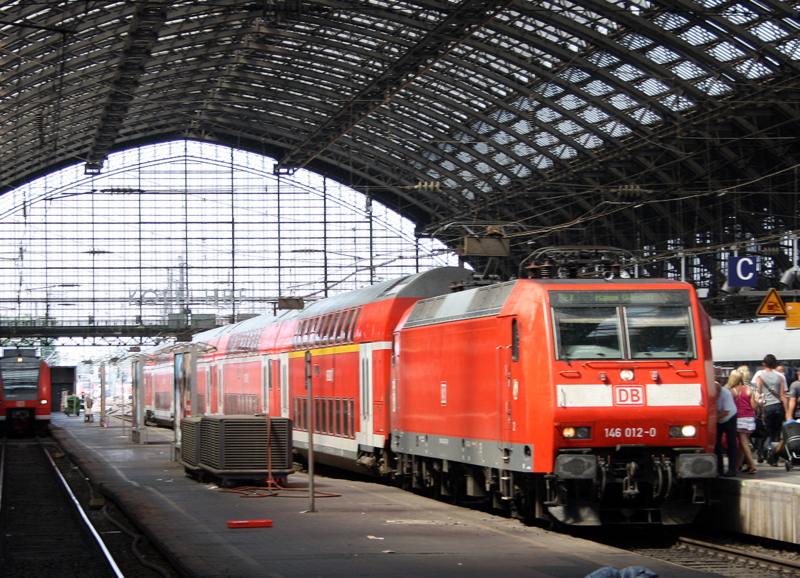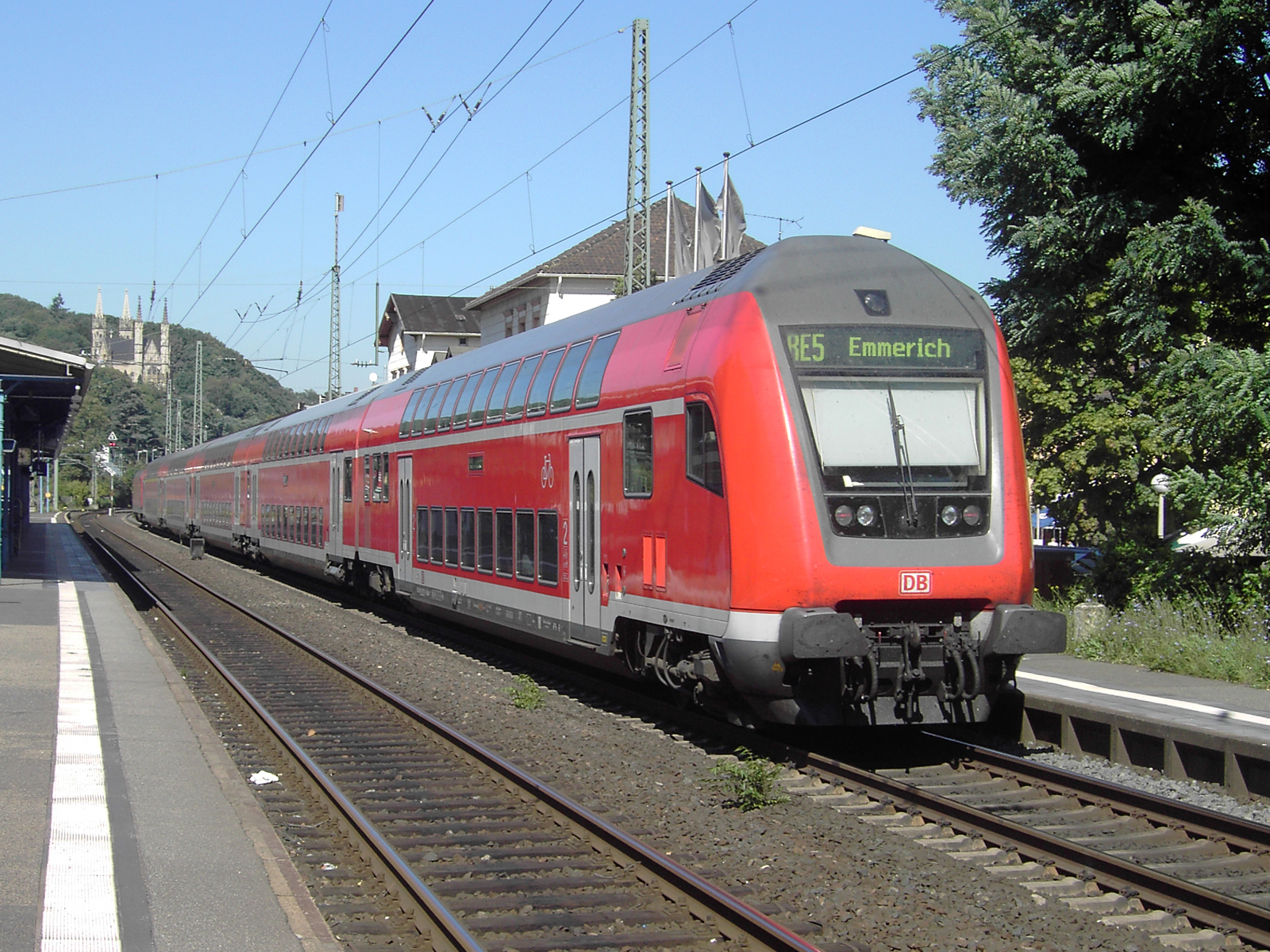|
Leverkusen Mitte Station
Leverkusen Mitte (''Bahnhof Leverkusen Mitte'') is a railway station on the Cologne–Duisburg railway, located in Leverkusen, Germany. It is classified by Deutsche Bahn as a category 4 station. It is served by the S6 line of the Rhine-Ruhr S-Bahn at 20-minute intervals. Train services The station is served by the following services: *Regional services NRW-Express ''Aachen - Cologne - Düsseldorf - Duisburg - Essen - Dortmund - Hamm - Paderborn'' *Regional services Rhein-Express The Rhein-Express is a Regional-Express (RE 5 (RRX)) service, which generally follows the Rhine (german: Rhein) river. It runs daily every hour from 5 am to 9 pm from Wesel via Oberhausen, Duisburg, Düsseldorf, Cologne, Bonn, Remagen and A ... ''Emmerich - Wesel - Oberhausen - Duisburg - Düsseldorf - Cologne - Bonn - Koblenz'' *Rhein-Ruhr S-Bahn services ''Essen - Kettwig - Düsseldorf - Cologne - Köln-Nippes'' Bus services It is also served by the following bus routes: 201 (20 minute ... [...More Info...] [...Related Items...] OR: [Wikipedia] [Google] [Baidu] |
Leverkusen
Leverkusen () is a city in North Rhine-Westphalia, Germany, on the eastern bank of the Rhine. To the south, Leverkusen borders the city of Cologne, and to the north the state capital, Düsseldorf. With about 161,000 inhabitants, Leverkusen is one of the state's smaller cities. The city is known for the pharmaceutical company Bayer and its sports club Bayer 04 Leverkusen. History The heart of what is now Leverkusen was Wiesdorf, a village on the Rhine, which dates back to the 12th century. With the surrounding villages which have now been incorporated, the area also includes the rivers Wupper and Dhünn, and has suffered a lot from flooding, notably in 1571 and 1657, the latter resulting in Wiesdorf being moved East from the river to its present location. During the Cologne War, from 1583 to 1588 Leverkusen was ravaged by war. The entire area was rural until the late 19th century, when industry prompted the development that led to the city of Leverkusen, and to its becoming ... [...More Info...] [...Related Items...] OR: [Wikipedia] [Google] [Baidu] |
North Rhine-Westphalia
North Rhine-Westphalia (german: Nordrhein-Westfalen, ; li, Noordrien-Wesfale ; nds, Noordrhien-Westfalen; ksh, Noodrhing-Wäßßfaale), commonly shortened to NRW (), is a States of Germany, state (''Land'') in Western Germany. With more than 18 million inhabitants, it is the List of German states by population, most populous state of Germany. Apart from the city-states, it is also the List of German states by population density, most densely populated state in Germany. Covering an area of , it is the List of German states by area, fourth-largest German state by size. North Rhine-Westphalia features 30 of the 81 German municipalities with over 100,000 inhabitants, including Cologne (over 1 million), the state capital Düsseldorf, Dortmund and Essen (all about 600,000 inhabitants) and other cities predominantly located in the Rhine-Ruhr metropolitan area, the largest urban area in Germany and the fourth-largest on the European continent. The location of the Rhine-Ruhr at the h ... [...More Info...] [...Related Items...] OR: [Wikipedia] [Google] [Baidu] |
Verkehrsverbund Rhein-Sieg
The Verkehrsverbund Rhein-Sieg (''Rhine-Sieg Transport Association''; VRS) is the public transport association covering the area of the Cologne/Bonn Region, North Rhine-Westphalia, Germany. It was founded on 1 September 1987, and covers an area of some 5.111 km² with some 3.3 million inhabitants. For the year 2009 nearly 494 million passengers were carried through the network of VRS.Ministerium f. Wirtschaft, Energie, Bauen, Wohnen und Verkehr des Landes NRW: Mobilität in Nordrhein-Westfalen. Daten und Fakten 2010 Verkehrsverbund Rhein-Sieg is named after the rivers Rhine (Rhein) and Sieg The Sieg is a river in North Rhine-Westphalia and Rhineland-Palatinate, Germany. It is a right tributary of the Rhine. The river is named after the Sicambri. It is in length. The source is located in the Rothaargebirge mountains. From h .... Associated transport companies Selected cities and parishes in the VRS area References External links vrsinfo.de- official site ... [...More Info...] [...Related Items...] OR: [Wikipedia] [Google] [Baidu] |
Germany
Germany,, officially the Federal Republic of Germany, is a country in Central Europe. It is the second most populous country in Europe after Russia, and the most populous member state of the European Union. Germany is situated between the Baltic and North seas to the north, and the Alps to the south; it covers an area of , with a population of almost 84 million within its 16 constituent states. Germany borders Denmark to the north, Poland and the Czech Republic to the east, Austria and Switzerland to the south, and France, Luxembourg, Belgium, and the Netherlands to the west. The nation's capital and most populous city is Berlin and its financial centre is Frankfurt; the largest urban area is the Ruhr. Various Germanic tribes have inhabited the northern parts of modern Germany since classical antiquity. A region named Germania was documented before AD 100. In 962, the Kingdom of Germany formed the bulk of the Holy Roman Empire. During the 16th ce ... [...More Info...] [...Related Items...] OR: [Wikipedia] [Google] [Baidu] |
Deutsche Bahn
The (; abbreviated as DB or DB AG) is the national railway company of Germany. Headquartered in the Bahntower in Berlin, it is a joint-stock company ( AG). The Federal Republic of Germany is its single shareholder. describes itself as the second-largest transport company in the world, after the German postal and logistics company / DHL, and is the largest railway operator and infrastructure owner in Europe. Deutsche Bahn was the largest railway company in the world by revenue in 2015; in 2019, DB Passenger transport companies carried around 4.8 billion passengers, and DB logistics companies transported approximately 232 million tons of goods in rail freight transport. The group is divided into several companies, including ''DB Fernverkehr'' (long-distance passenger), '' DB Regio'' (local passenger services) and ''DB Cargo'' (rail freight). The Group subsidiary ''DB Netz'' also operates large parts of the German railway infrastructure, making it the largest rail network in ... [...More Info...] [...Related Items...] OR: [Wikipedia] [Google] [Baidu] |
German Railway Station Categories
The approximately 5,400 railway stations in Germany that are owned and operated by the Deutsche Bahn subsidiary DB Station&Service are divided into seven categories, denoting the service level available at the station. This categorisation influences the amount of money railway companies need to pay to DB Station&Service for using the facilities at the stations. Categories Category 1 The 21 stations in Category 1 are considered traffic hubs. They are permanently staffed and carry all sorts of railway-related facilities, as well as usually featuring a shopping mall in the station. Most of these stations are the central (commonly referred to as main) stations (''Hauptbahnhof'' or ''Hbf'') of large cities with 500,000 inhabitants and above, though some in smaller cities, such as Karlsruhe Hauptbahnhof, are regarded as important because they are at the junction of important railway lines. Berlin, Hamburg, Munich and Cologne, the four biggest cities in Germany, have more than ... [...More Info...] [...Related Items...] OR: [Wikipedia] [Google] [Baidu] |
S6 (Rhine-Ruhr S-Bahn)
Line S 6 is a S-Bahn line in the Rhein-Ruhr network. It calls, among others, at the cities of Essen, Düsseldorf and Cologne and was the first S-Bahn line in the Rhine-Ruhr network, becoming operational on 28 September 1967 between Ratingen Ost and Düsseldorf-Garath. It is operated at 20-minute intervals using coupled sets of class 422 four-car electrical multiple units. Line S 6 runs over lines built by various railway companies: * from Essen Hauptbahnhof to Essen-Werden over the Essen-Werden–Essen railway, opened by the Bergisch-Märkische Railway Company in 1877, * from Essen-Werden to Düsseldorf Hauptbahnhof over the Ruhr Valley Railway, opened by the Bergisch-Märkische Railway Company in 1872 and 1874, * from Düsseldorf to Cologne over the Cologne–Duisburg railway, opened by the Cologne-Minden Railway Company in 1845 and * from Cologne to Köln-Nippes over the West Lower Rhine Railway The Left Lower Rhine line (german: Linksniederrheinische Strecke) is a main line ... [...More Info...] [...Related Items...] OR: [Wikipedia] [Google] [Baidu] |
Rhine-Ruhr S-Bahn
The Rhine-Ruhr S-Bahn (german: S-Bahn Rhein-Ruhr) is a polycentric and electrically driven S-train network covering the Rhine-Ruhr Metropolitan Region in the German federated state of North Rhine-Westphalia. This includes most of the Ruhr (and cities such as Dortmund, Duisburg and Essen), the Berg cities of Wuppertal and Solingen and parts of the Rhineland (with cities such as Cologne and Düsseldorf). The easternmost city within the S-Bahn Rhine-Ruhr network is Unna, the westernmost city served is Mönchengladbach. The S-Bahn operates in the areas of the Verkehrsverbund Rhein-Ruhr and Verkehrsverbund Rhein-Sieg tariff associations, touching areas of the Aachener Verkehrsverbund (AVV) at Düren and Westfalentarif at Unna. The network was established in 1967 with a line connecting Ratingen Ost to Düsseldorf-Garath. The system consists of 16 lines. Most of them are operated by DB Regio NRW, while line S28 is operated by Regiobahn and S7 by Vias. The S19 will run 24/7 between ... [...More Info...] [...Related Items...] OR: [Wikipedia] [Google] [Baidu] |
NRW-Express
The NRW-Express is a Regional-Express rail service in the German state of North Rhine-Westphalia (NRW), running from Aachen via Cologne, Düsseldorf, Duisburg, Essen, Bochum and Dortmund to Hamm as line RE 1. The line is part of the Rhine-Ruhr Express (RRX) network and is operated by National Express. The service has one of the highest levels of patronage in Germany with about 110,000 passengers per day, mainly commuters and students. History Today's ''NRW-Express'' replaced existing express services on individual sections of the route after the regionalisation of transport in Germany. A number of stations previously served by long-distance trains, such as Düsseldorf-Benrath and Wattenscheid came to be served by regional services only. The NRW-Express was first classified as ''Regionalschnellbahn'' ("regional fast train") RSB 1, then as ''StadtExpress'' ("city express") SE 1 and eventually as ''Regional-Express'' RE 1, when it was also given the name of ''NRW-Express''. T ... [...More Info...] [...Related Items...] OR: [Wikipedia] [Google] [Baidu] |
Rhein-Express
The Rhein-Express is a Regional-Express (RE 5 (RRX)) service, which generally follows the Rhine (german: Rhein) river. It runs daily every hour from 5 am to 9 pm from Wesel via Oberhausen, Duisburg, Düsseldorf, Cologne, Bonn, Remagen and Andernach to Koblenz, in the German states of North Rhine-Westphalia and Rhineland-Palatinate. It is the fourth-most used regional express line in the VRR network with approximately 48,000 passengers a day. Until the timetable change in December 2016, the Rhein-Express ran to/from Emmerich. Operations on this section and the additional services provided by Regionalbahn service RB 35 (''Der Weseler'') have since been operated as part of the Rhein-IJssel-Express (RE 19). History The ''Rhein-Express'' was established in 1998 with the introduction of the integrated regular interval timetable in North Rhine-Westphalia (called ''NRW-Takt'') by combining two services that previously started or finished in Cologne. Originally, the RE 5 service stop ... [...More Info...] [...Related Items...] OR: [Wikipedia] [Google] [Baidu] |
Buildings And Structures In Leverkusen
A building, or edifice, is an enclosed structure with a roof and walls standing more or less permanently in one place, such as a house or factory (although there's also portable buildings). Buildings come in a variety of sizes, shapes, and functions, and have been adapted throughout history for a wide number of factors, from building materials available, to weather conditions, land prices, ground conditions, specific uses, prestige, and aesthetic reasons. To better understand the term ''building'' compare the list of nonbuilding structures. Buildings serve several societal needs – primarily as shelter from weather, security, living space, privacy, to store belongings, and to comfortably live and work. A building as a shelter represents a physical division of the human habitat (a place of comfort and safety) and the ''outside'' (a place that at times may be harsh and harmful). Ever since the first cave paintings, buildings have also become objects or canvasses of much artistic ... [...More Info...] [...Related Items...] OR: [Wikipedia] [Google] [Baidu] |
.jpg)





